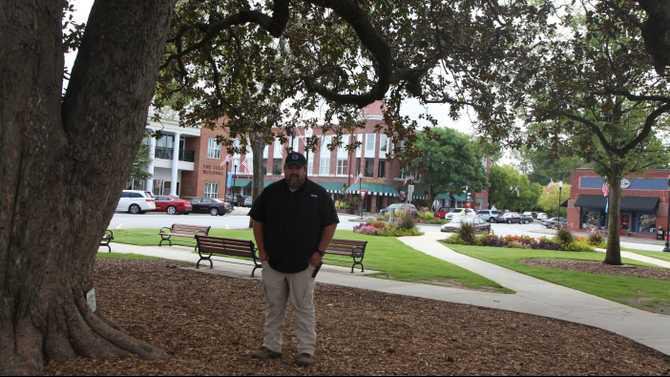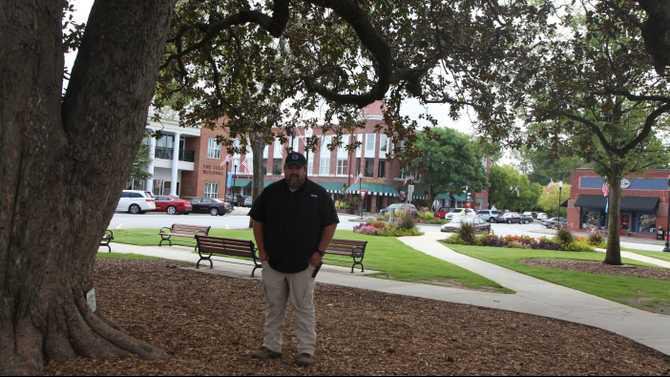Once, they were suckers.
Then, they were stems bunched so close together that they started to share bark.
Now, more than 100 years later, the two magnolias standing across from each other on Covington’s historic Square, are massive, casting deep pools of shade over the walkways, grass and the Confederate Monument.
“We have a photograph that’s dated in the early quarter of the 20th Century and you can see the magnolias there,” said Randy Vinson, Planning and Zoning Director for the city of Covington. “They were pretty big then, though not nearly as big as they are now. That means they are probably approaching the end of the lives.”
Native to the Southeast, the average lifespan of the magnolia grandiflora, the Southern magnolia, is 80 years, though some experts say the trees can live more than a century. But past 100 years, the towering magnolias that seem integral to the Square’s identity need extra attention to remain healthy.
That’s where city arborist Kevin Sorrow and Arbor Equity of Covington, the company hired by the city to help maintain the trees on the Square, come in to play. The city, Sorrow said, is doing everything it can to keep the trees healthy.
“They are reaching the end of their life span,” Sorrow said, echoing Vinson. “Sometime the magnolias will have to be replaced.”
For now, he said, “We’re using all the tools in the toolbox to maintain the health of the trees on the square. Arbor Equity does preventative pruning to make sure no dead limbs fall. That’s always a hazard.”
The tools Sorrow refers to include the cables and braces that stabilize the massive branches. Looking up through the dark green leaves, it’s hard to see the bolts and braces against the smoky grey bark, but they are there, pegging together massive stems and lacing together branches.
The cables and braces help prevent damage during wind storms.
Arbor Equity has the trees on the Square under a fertilization and insect treatment cycle, Sorrow said. Recently, the ground along the magnolia’s drip line was “air spaded,” a process of using a pneumatic tool to pump air into the ground, fracturing the thick Georgia red clay to aerate the soil to allow better air and water circulation.
That, Sorrow said, allows nutrients to reach the unusual, rope-like root system. The roots grow close to the surface, most sitting within the top foot of soil and can extend out four times the width of the canopy.
Foot traffic compacts the soil, strangling the roots and preventing needed nutrients. To further protect the trees, Sorrow said, six inches of mulch was laid down around both trees, cushioning the ground and providing protection from heavy pedestrian traffic.
What happens when ...
Newton County owns the historic Square Park. However, through an intergovernmental agreement, the county has turned care of the Square over to the city.
“About three years ago, the [Covington city] council said we needed to make improvements to the Square,” Vinson said. “It was looking pretty dowdy. The city approached the county and said, ‘let us make all the improvements’.”
The county agreed. Changes cannot be made to the Square without the BOC’s okay, and approval was given to a proposed plan for the Square that included replacing the maple trees around the outside of the Square with willow, red and white oaks. [See “City unveils plans for square,” at http://www.covnews.com/archives/50018/.]
In 2005, a white oak, Quercus alba, was planted on the southeast quadrant. The tree has a lifespan of between 300 and 600 years, and can grow more than 120 feet tall with a corresponding width. Donated by the Charlie Elliott Wildlife Center, the oak is 10-inches in diameter, but most people don’t notice, Sorrow said, because it sits in the shadows of the magnolias.
Eventually, he said, the white oak canopy will provide as much shade as the magnolias currently provide.
Vinson’s plan for replanting and landscaping the square is as much for future generations as it is for those who enjoy the Square’s park-like setting today.
“There was no sense of unity when the trees were planted,” Sorrow said. “I don’t know why [the magnolias] ended up as the focal point of the square. There are old pictures at city hall that show the Square was totally forested. I remember there was a big oak that had died and was cut down years ago.”
Some of that haphazard design is still evident on the Square. A couple of tall but scraggly maples stand, a dead pecan was recently removed and a Chinese pistache near the entrance of Scoops is one of the larger streets trees on the square. But as those trees die off, they will be replaced by willow oaks and red maples. It’s part of Vinson’s long-range vision for the square, Sorrow said.
“Willow oaks have proven to be very hardy appropriate urban street trees,” Vinson said. “Their leaves are small so they can be managed better than the maples and oaks. They don’t have a heavy root structure that heaves sidewalks. You can get a lot more life out of the tree.”
Willow oaks and white oaks have long life spans — well past 300 years — and are better suited to an urban environment than the magnolias, Vinson said. The city wants to being planting new trees now so that by the time the magnolias die, other trees will have reached maturity, ensuring that the Square still has trees with full canopies to preserve its look.
The oaks won’t be the only species of tree planted on the Square. Vinson, who has a master’s degree in landscape architecture, said it is important to have different varieties of trees. “We don’t want to run the risk of blight, like what happened with the American Elm,” he said.
The preferred street tree of the 19th century, the American elm was almost completely obliterated when Dutch elm disease began killing them off. By the 1970s, it looked as if the entire species had been wiped out. Recently, a few stands of healthy elms have been discovered and arborists are working to revive the species.
The pros and cons of change
Standing beneath one of the magnolia trees, Sorrow points to a low dipping, 10-inch diameter branch and said the branch is trying to root itself to create new trees, similar to how willow trees will propagate.
The stately magnolias on the square began life as suckers, Sorrow said. The suckers grew into stems, that thickened and thickened and thickened, pushing up against each other. While the trunks of the trees may look massive, Sorrow said, in reality two trees are a collection of huge stems that have been joined by a thin layer of bark.
“It’s called included bark,” Sorrow said. “The stems share the bark but it’s a weak attachment.”
It’s why there are 1-inch diameter rods threading the stems together near where the included bark separates to follow individual branches.
Magnolias, Vinson said, do not make good urban trees. “The leaves are massive,” he said. ‘They require a great deal of maintenance to keep the leaf litter cleaned up.”
They are also opaque, Vinson said, meaning until the trees get tall enough, the leaf cover is thick, making it difficult to see beyond the tree. “That takes quite a while on a magnolia,” he said. “The trees were probably 80-years-old before they ‘limbed up.’”
“Limbing up” is when lower branches of trees are pruned to provide clear site lines for pedestrians and vehicles.
Vinson understands those people in the community who want the magnolias to stay, “maintaining the same appearance everyone has come to love. What they don’t understand is [if we replace the magnolias, they won’t] be 80-feet tall like those are. They’ll only be 18-feet tall.”
That doesn’t mean that magnolias won’t be used to replace the existing trees, Vinson said. Plans are to plant some magnolias at the Covington-Newton County Land Application facility this year, “growing them so they would be quite large when we transplant them.
“We’ll have the opportunity to make changes to the plan, depending on the desires of the BOC and the city council,” Vinson said. “They would have large magnolias if they want to go that way, or they can go with larger shade trees [like the oaks]. Either way, we’ll have trees ready to go.”
No matter what trees are planted, Vinson said, the landscaping and care of the historic square is important to the community.
“You want to have a great looking public space downtown,” he said, adding people want to take pride in the community where they live. “As far as economic development goes, a lot of business leaders will judge a community on how well they take care of the public space.”
Originally, the plan was to work on a quadrant of the square at a time, removing and replacing the dead and dangerous trees.
“When we did the [first] quadrant, everyone involved took a public lashing for cutting down the trees,” Vinson said. “We were looking at doing a quadrant a year, and we would be approaching [work on] the last quadrant.”
Because of the public outcry, Vinson said, that plan was put on hold.
“The intent was to create a uniform canopy over the streets and the sidewalks,” Vinson said. “At the time we proposed all this, we were saying we needed to come up with a plan when the magnolias [died].”
“My job is to maintain the trees,” Sorrow said of the magnolias. “We are trying to keep them happy and healthy. At this time, I don’t see any problems.”





